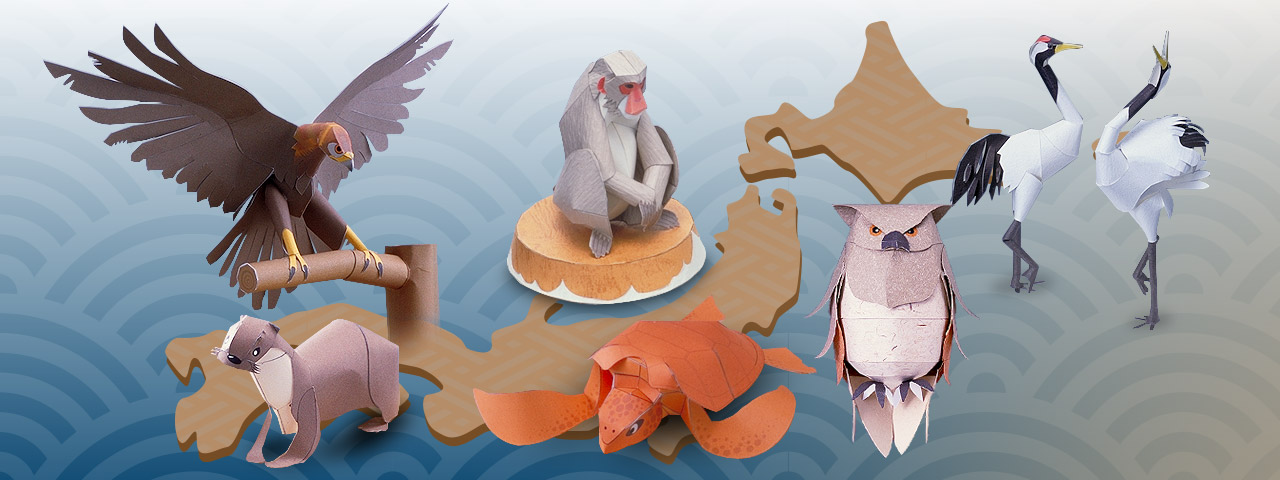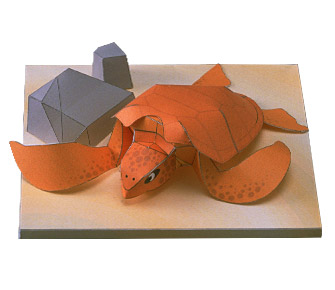Loggerhead Turtle
Papercraft kit : The loggerhead turtle, auspicious for its famed longevity.

The sea turtle, a symbol of long life and good luck, has been loved for centuries. The Loggerhead Turtle, belonging to the sea turtle family, makes its home in the seas of tropical and temperate regions. However, the number of Loggerhead Turtles has been decreasing due to waste disposal problems, land reclamation projects, and contamination of the oceans. The Loggerhead Turtle is currently classified as a “Endangered [EN]” species in the Red List.
Assembly instructions for paper sculptures of the rare loggerhead turtle, as well as photo images of completed sculptures, may be downloaded at this web site.
Download - Parts sheet & InstructionsThis data was released in July, 1999.
Loggerhead Turtle - Animal Guide

- Loggerhead Turtle - Cheloniidae
- Carreta caretta
- 70 to 200 cm (28 to 80 in.) long
- RED DATA BOOK (RDB) categories : Endangered [EN]
The Loggerhead Turtle (Carreta caretta), a member of the sea turtle family, is a large marine animal sometimes reaching two meters (approximately six feet eight inches) in length. The Loggerhead Turtle is characterized by its auburn body and heart-shaped shell hollowed at the neck. It swims gracefully through the water using long, flat fore flippers and hind flippers, which determine the direction of its course.
The Loggerhead Turtle feeds on crustaceans such as shellfish and crabs, and occasionally jellyfish.
When laying eggs, the female Loggerhead Turtle chooses locations further north in latitude than any other sea turtle. During the egg-laying period from May to July, she rides on the Japan Current, eventually landing on the Pacific coastline in search of sand dunes for her nest. At night when no one is around, the turtle digs an egg chamber with her hind flippers about 50 centimeters (20 inches) deep to lay approximately 120 eggs resembling ping pong balls in shape. She repeats this task three to four times until the end of August.
However, the number of beaches where the Loggerhead Turtle may spawn has been decreasing as a result of illegal waste disposal and land reclamation projects as well as ocean contamination. In addition, some people steal the eggs, drive on the beach, or chase the turtles at night for amusement. In order to solve these problems, a variety of non-governmental voluntary organizations all over Japan have been making an active effort to clean the beaches and preserve the Loggerhead Turtle.


Habitat
The Loggerhead Turtle inhabits primarily the Pacific, Atlantic, and Indian Oceans, traveling broadly throughout tropical and temperate zones. In Japan, it can be seen along the Pacific Coast of Ibaragi Prefecture and southward, as well as along beaches south of the Noto Peninsula. The Loggerhead Turtle is designated as a natural treasure by the Japanese government. As frequent spawning locations of the Loggerhead Turtle, Shizuoka, Tokushima, and Kagoshima Prefectures are very active in the protection of and educational campaigns for this vulnerable creature.

Photographed by Kamehameha-Okoku
About RED DATA BOOK
The Red Data Book is a report compiled by the Environment Agency classifying various threatened animals in Japan and their present status. From a biological viewpoint, the Environment Agency has evaluated the extinction risk level of each individual taxon and compiled a list for the Red Data Book. However, the Book possesses no legal power to enforce regulations concerning threatened species.
The Red Data Book is broadly employed as fundamental information for advancing the preservation of threatened wild animals.
| EXTINCT | EX | A taxon considered to have become extinct in Japan. |
|---|---|---|
| EXTINCT IN THE WILD | EW | A taxon known to survive only under conservation or in captivity. |
| CRITICALLY ENDANGERED | CR | A taxon facing an extremely high risk of extinction in the wild in the immediate future. |
| ENDANGERED | EN | A taxon facing a very high risk of extinction in the wild in the near future though not critically endangered. |
| VULNERABLE | VU | A taxon facing a high risk of extinction in the wild in the medium-term future though not critically endangered or endangered. |
| NEAR THREATENED | NT | A taxon which can qualify for VULNERABLE in the future depending on its habitat conditions, although it is not facing a high risk of extinction at this present stage. |
| DATA DEFFICIENT | DD | A taxon about which there is not adequate information to make a direct, or indirect, assessment of its risk of extinction. |
| THREATENED LOCAL POPULATION | LP | A taxon facing a high risk of extinction in a certain locality among its limited specific habitats. |
From Environment Agency press materials










